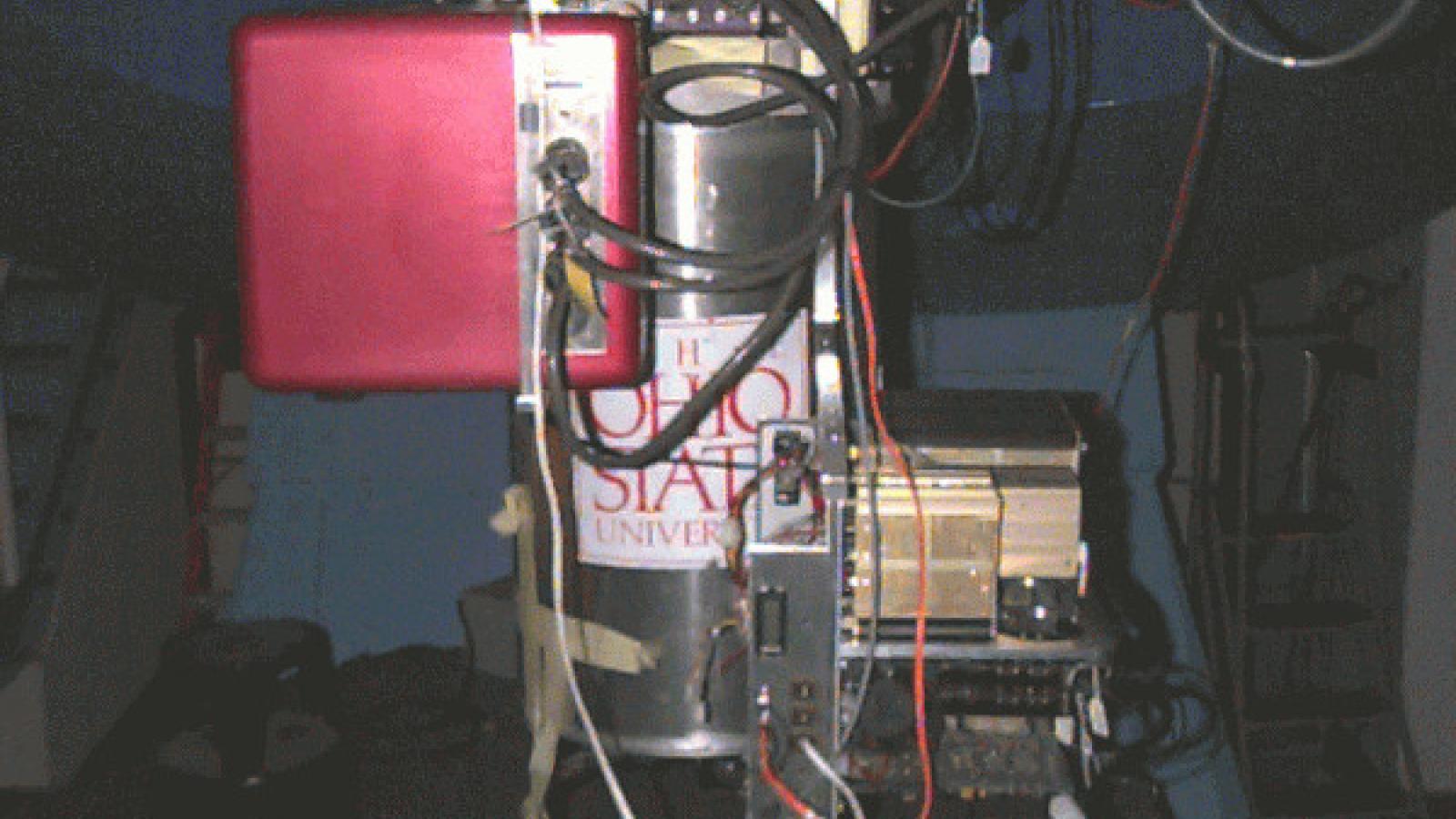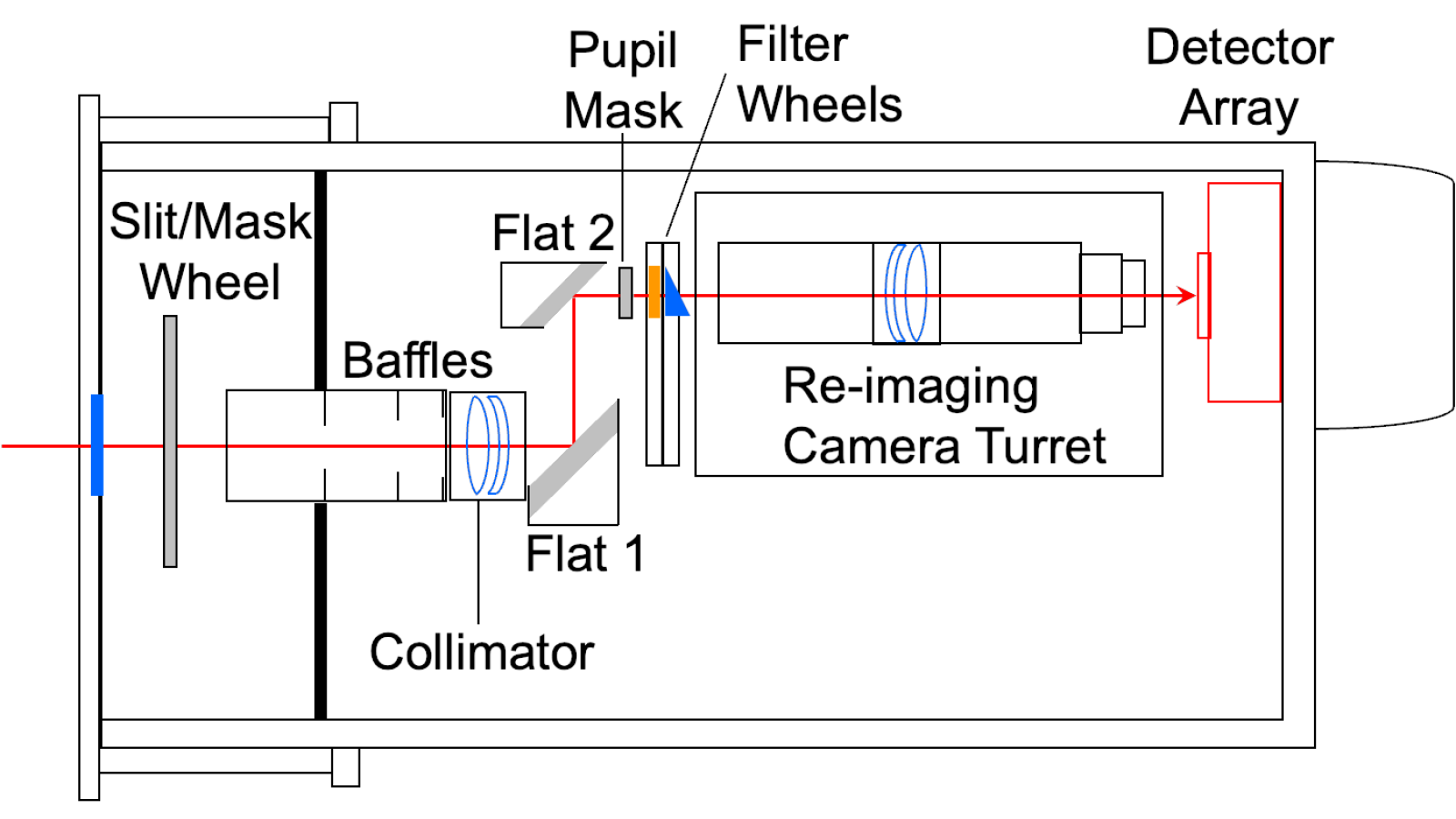TIFKAM
TIFKAM is a multi-purpose infrared imager and spectrometer designed for operation at 0.9-2.5 micron wavelengths that followed the successful OSIRIS design and was built as part of a joint MDM, Kitt Peak, OSU collaboration. TIFKAM has had two different IR arrays over its life. The first was a 512x1024 ALADDIN InSb array provided by NOAO and used from 1996 until 2000. The second was a a 1024x1024 HAWAII-1R HgCdTe detector purchased for TIFKAM by Dartmouth with an NSF MRI grant.
TIFKAM has selectable re-imaging cameras provide a choice of two plate scales and a variety of spectroscopic resolutions. Internal mechanisms control the selection of filters, dispersers, focal-plane masks, and cameras. It was used on the Kitt Peak 2.1m and 4m Blanco telescopes from 1997 until 2000 (where it was available to the US community as a facility instrument), then moved permanently to the MDM 2.4m Hiltner telescope where it operated from 2001 until its retirement in 2018.
TIFKAM was OSU's first adaptive optics instrument when it spent a week at the Starfire Optical Range 1-m telescope at Kirkland AFB in New Mexico as a visiting instrument as part of a joint NSF/USAF laser guide-star adaptive optics demonstration project in 1996.
Instrument Specification
- Project type: Facility Instrument - near-IR imager and spectrometer
- Wavelength: 0.9 to 2.5-microns
- Resolution: R=720 - 1500 using grisms
- Imaging Filters: zJHK and narrow band (H2, Br-gamma)
- Field of View: 1-5 arcmin depending on camera selection (f/5, f/7.5, f/16.6)
- Mode/Modes: seeing-limited imaging and grism long-slit spectroscopy, slitless spectroscopy
- Primary science: stellar, nebular, galactic, extragalactic, solar system
- Telescopes: Starfire Optical Range 1m (1996), Kitt Peak 2.2m (1997-2000), MDM 2.4m (2001-2018)
- Years active: 1996-2018
- Reference: Pogge et al. 1998, Proc SPIE, 3354, 414P
Instrument Facts
- Second cryogenic IR instrument built by OSU, first to use an InSb array with an embedded micro cryocooler
- Its first IR array was an 1024x512 ALADDIN InSb array on loan from NOAO.
- Its second IR array was a 1024x1024 Hawaii-1 (H1R) array installed when it moved permanently to MDM in 2001.
- Its first time on-sky was at the Starfire Optical Range (SOR) 1-m telescope at Kirkland AFB in 1996 as part of a joint NSF/USAF project to introduce US astronomers to laser guide star adaptive optics.
- Originally designed to work at the MDM 2.4m and 1.3 m telescope, it proved too heavy for the 1.3m until that telescope's drives were updated in 2010.
- Used the second iteration of the OSU "Big D" cryogenic optical bench.
The instrument was originally named "MOSAIC", an acronym for "MDM/Ohio State Active Infrared Camera", as the initial design included an internal tip-tilt system to correct first-order image motion ("active optics") to improve image quality. The tip-tilt system was never implemented, instead we were loaned a 512x1024 ALADDIN InSb array by NOAO in return for providing US community access at the KPNO 4m and 2.1m telescopes. The problem was, MOSAIC was also the name of the 8Kx8K CCD imager at KPNO, and to avoid confusion it needed a new name. Over dinner in the Kitt Peak diner, KPNO's Mike Merrill suggested the name "The Instrument Formerly Known As MOSAIC", hence TIFKAM, which stuck.
Instrument Team
Darren DePoy (OSU PI)
Ian Gatley (KPNO lead)
Richard Pogge (instrument scientist, SOR AO campaign lead)
Mike Merrill (KPNO detector lead)
Paul Byard (Optical Designer)
Bruce Atwood (OSU detector lead)
Tom O'Brien (Mechanical Engineer)
Jerry Mason (Software Systems Developers/Engineer)
Arne Henden (Software engineer)
Daniel Pappalardo (Electrical Engineer)
Ed Teiga (Electronics Technician)
Dave Brewer (Senior Instrument Maker)
Dave Steinbrecher (Senior Instrument Maker)
Paul Martini (Graduate student)
Andrew Stephens (Graduate student)
Fred Vrba (NOAO staff)



